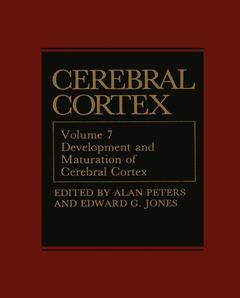Description
Cerebral Cortex, Softcover reprint of the original 1st ed. 1988
Development and Maturation of Cerebral Cortex
Cerebral Cortex Series, Vol. 7
Coordinators: Peters Alan, Jones Edward G.
Language: English
Subject for Cerebral Cortex:
Publication date: 06-2012
536 p. · 20.3x25.4 cm · Paperback
536 p. · 20.3x25.4 cm · Paperback
Description
/li>Contents
/li>
The previous volumes in this series have dealt with the mature cerebral cortex. In those volumes many of the structurally and physiologically distinct areas of the cerebral cortex, their connections, the various types of neurons and neuroglial cells they contain, and the functions of those cells have been considered. In the present volume the contributions focus on the development of the neocortex and hippocampus. Chapters in this volume describe how the neurons migrate in the cortex to attain their ultimate positions, and emphasize the role played by the preexisting pallium or primordial plexiform layer of the cerebral vesicle in the development of the cerebral cortex. The primordial plexiform layer becomes split by the invasion of neurons that will form the cortical plate, and mutants in which the neuronal migration is abnormal provide valuable information about the role of the radial glial cells in this migration. It is also made clear that although the mechanics of development in the hippocampus are similar to those in the neocortex, the development of the hippocampus involves some unique features. For example, neuronal proliferation in the dentate gyrus continues well into postnatal life.
1 Early Ontogenesis of the Human Cerebral Cortex.- 1. Introduction.- 2. Historical Perspectives.- 3. Origin and Early Ontogenesis of the Human Cerebral Cortex.- 4. Differentiation and Maturation of the Mammalian Cortical Plate.- 5. Conclusions.- 6. References.- 2 The Role of the Subplate in the Development of the Mammalian Telencephalon.- 1. Introduction.- 2. Development of Geniculocortical Connections.- 3. Neurogenesis of Cortical Layer 4.- 4. Cellular Organization of the White Matter during Development.- 5. The Subplate Is a Transient Synaptic Neuropil.- 6. The Subplate and Marginal Zones Contain a Transient Class of Peptide-Immunoreactive Neuron.- 7. The Role of Subplate Neurons in Cortical Development.- 8. References.- 3 The Reeler Malformation: Implications for Neocortical Histogenesis.- 1. Introduction.- 2. Neuronal Migration.- 3. Neuron Position and Secondary Events of Neocortical Histogenesis.- 4. Recapitulation and Implications.- 5. References.- 4 The Development of the Hippocampal Region.- 1. Introduction.- 2. The Hippocampal Region in the Adult Brain.- 3. The Generation of Neurons in the Hippocampal Region.- 4. The Migration of the Neurons in the Hippocampal Region.- 5. The Development of Neuronal Form in the Hippocampal Region.- 6. The Development of the Afferents to the Hippocampal Region.- 7. The Development of Efferents from the Hippocampal Region.- 8. Other Aspects of the Development of the Hippocampal Region.- 9. References.- 5 Development of Projection and Local Circuit Neurons in Neocortex.- 1. Introduction.- 2. Projection Neurons.- 3. Local Circuit Neurons.- 4. Summary and Conclusions.- 5. References.- 6 Changes in Neurotransmitters during Development.- 1. Introduction.- 2. Excitatory Amino Acids.- 3. Acetylcholine.- 4. GABA.- 5. Neuropeptides.- 6. Monoamines.- 7. References.- 7 Biochemistry of Neurotransmitters in Cortical Development.- 1. Introduction.- 2. Afferent Pathways to Cortex.- 3. Intrinsic Cortical Neurons.- 4. Glutamate Pathways.- 5. Conclusion.- 6. References.- 8 The Physiology of Developing Cortical Neurons.- 1. Introduction.- 2. Spontaneous Unitary Activity.- 3. Evoked Potentials in Immature Neocortex.- 4. Postsynaptic Potentials in Immature Cortical Cells.- 5. Latencies of Evoked Neuronal Activity.- 6. Nature of Unit Responses in Immature SmI Cortex.- 7. Receptive Field Organization in Immature SmI Cortex.- 8. Cortical Morphology and Functional Development.- 9. Laminar Development of Visual Cortex.- 10. Receptive Field Organization in Immature Visual Cortex.- 11. Conclusions.- 12. References.- 9 Changes in Cytoskeletal Elements during Postnatal Development of Cerebral Cortex.- 1. Introduction.- 2. Composition of Neuronal Cytoskeleton.- 3. Heterogeneity.- 4. Distribution.- 5. Potential Functions of Cytoskeletal Elements in Nerve Cells.- 6. Cytoskeletal Changes during Postnatal Brain Development.- 7. The Cytoskeleton and Functionally Driven Plasticity.- 8. References.- 10 Development of Visual and Auditory Cortical Connections in the Cat.- 1. Introduction.- 2. Development of Cerebral Hemispheres and Commissures.- 3. General Considerations of Pathway Tracing Techniques in Immature Animals.- 4. Organization of Corticosubcortical Projections during Development.- 5. Organization of Corticocortical Projections during Development.- 6. Synapse Formation and Receptor Appearance.- 7. Development of Functional Connections.- 8. Experientially Induced Reorganization of Cortical Connections.- 9. Cortical Ablation Studies.- 10. Conclusions and Speculations.- 11. References.- 11 Plasticity of Synapse Structure and Pattern in the Cerebral Cortex.- 1. Introduction.- 2. Evidence for Changes in Preexisting Synapses.- 3. Synaptic Number and Pattern Changes.- 4. How Do Synapse Number Changes Arise? Developmental and Mature Forms of Synaptogenesis.- 5. Other Features of Developmental Plasticity of Cerebral Cortex.- 6. Concluding Comments.- 7. References.- 12 Effects of Nutrition on Cortical Development.- 1. Introduction.- 2. Historical Perspectives.- 3. Animal Models.- 4. General Morphological Effects of Experimentally Induced Undernutrition.- 5. Histological Studies on the Brains of Undernourished Animals.- 6. Undernutrition and Environment.- 7. Concluding Remarks.- 8. References.- 13 Embryonic Vascularization of the Mammalian Cerebral Cortex.- 1. Introduction.- 2. Materials and Methods.- 3. The Endothelial Cell of CNS Growing Capillaries.- 4. CNS Capillary Angiogenesis, Anastomosis, and Lumen Formation.- 5. Embryonic Vascularization of Cerebral Cortex.- 6. Conclusions.- 7. References.
© 2024 LAVOISIER S.A.S.




